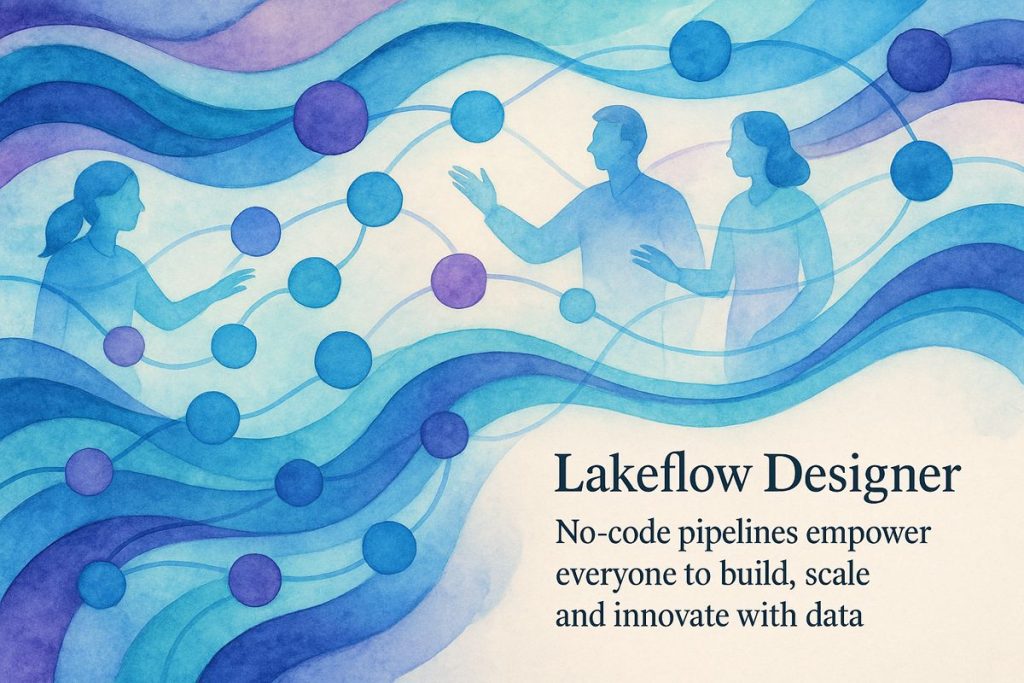Databricks Lakeflow Designer is a no-code, AI-powered tool that lets anyone build data pipelines by simply dragging and dropping pieces together, like playing with LEGO. It’s easy and fast, so even non-technical users can create powerful workflows before their coffee gets cold. The tool makes sure everything is safe, follows rules, and works smoothly with Databricks’ bigger platform, helping big companies stay in control. With features like built-in AI helpers and teamwork tools, Lakeflow Designer is bringing data magic to everyone, not just code experts. Thousands of organizations are already using it, making data work simpler, faster, and way more fun.
What is Databricks Lakeflow Designer and how does it benefit data pipeline development?
Databricks Lakeflow Designer is a no-code, AI-powered tool for building data pipelines using a visual drag-and-drop interface. It enables both technical and non-technical users to quickly create, govern, and deploy workflows, ensuring compliance, scalability, and seamless integration with Databricks’ Data Intelligence Platform.
Coffee, Complexity, and the Democratization of Data
Let’s set the scene: it’s well past midnight, the faint hum of my laptop mixing with the bitter aroma of burnt espresso, and I’m staring at a drag-and-drop canvas that promises to make ETL as easy as rearranging fridge magnets. Enter Databricks Lakeflow Designer—a tool with the audacity to claim it’ll democratize data pipeline development for the masses. I’ll admit, I was skeptical at first (who wouldn’t be, after years of deciphering obtuse YAML in Apache Airflow?), but there’s something in the way Lakeflow Designer marries no-code ambition with a dash of hyperspectral AI assistance that made me raise an eyebrow.
I mean, is this the beginning of the end for the “data engineer as gatekeeper”? Or just another palimpsest in the relentless rewriting of analytics history? Databricks, that ever-present colossus in unified analytics, clearly thinks it’s the former—and if you squint just right, maybe they’re right.
Visual Storytelling with AI: Making Pipelines as Intuitive as LEGO
Lakeflow Designer isn’t just a rehash of old ETL metaphors; it’s a bold, visual playground. Imagine a workspace where business analysts and ops folks can drag, drop, and wire up sophisticated workflows while sipping their morning kombucha. The interface is supremely tactile—boxes and connectors snap together with a soft click, the whole thing running smoother than a well-oiled Kafka producer.
What really tickled my neural pathways was the generative AI assistant. Type, “Pull last quarter’s sales from Salesforce, blend it with support tickets, and send it to Tableau,” and—bam!—the canvas blooms with the requisite transformations. No more squinting at a labyrinthine wall of SQL or gnawing on the edge of frustration when a semicolon goes astray. It’s like having a sous-chef for your data kitchen, minus the Gordon Ramsay expletives.
I once tossed a vague, hand-wavy request into the AI: “Get me anomalies since January.” In seconds, it spun up a pipeline that identified outliers in our order logs. The result? Relief, tinged with a smidge of professional jealousy. Can you blame me? Even my inner curmudgeon can’t knock the onboarding experience—rookies can build something useful before the espresso cools.
Governance, Standards, and the Sound of Compliance
But here’s the rub: no-code tools have a reputation for crumpling under enterprise scrutiny. Lakeflow Designer sidesteps this pitfall with the precision of a chess grandmaster. Pipelines you build—whether you’re a buttoned-up engineer or a spreadsheet virtuoso—are corralled inside the Databricks Data Intelligence Platform, inheriting its robust governance, security, and hyperscale reliability.
Every workflow conforms to open standards, namely ANSI SQL, and, more intriguingly, Spark Declarative Pipelines—Databricks’ own contribution to the open-source canon. (They even donated the framework to Apache Spark, which is more altruistic than most unicorns get credit for.)
If you’re in a regulated field—say, the labyrinthine world of pharmaceuticals or life sciences—rest easy knowing compliance isn’t an afterthought but baked right into the pie.
Oh, and backward compatibility with Delta Live Tables? That’s not just a footnote—it’s a bridge for those unwilling (or unable) to torch their old investments as they leap into the future. I had to stop and ask myself: how often do tools make upgrades this painless? Not often enough.
Modern IDE Meets Collaborative Alchemy
Let’s not ignore the new integrated development environment (IDE) Databricks has rolled out. It’s not quite the Bauhaus of data engineering, but it does have a certain ruthless elegance—pipelines, monitoring, deployment, and collaboration all in one window. The effect? Fewer tabs, more sanity. I remember the first time I toggled between a team member’s workflow and my own—no more accidental overwrites or Slack-fueled blame games. Just a low-key, shared workspace that feels like a whiteboard session with less marker on your hands.
Collaboration here isn’t just a buzzword. The platform encourages reuse and operational rigor, even as it welcomes non-coders into the fold. There’s a faint sense of camaraderie as you watch a workflow evolve in real time—a kind of digital symphony, if you’ll forgive the overstretched metaphor.
Adoption: From Curiosity to Enterprise Stampede
Now, here’s a number that stuck with me like the jingle from a vintage IBM commercial: over 20,000 apps created by 2,500 organizations during the Lakeflow public preview (Databricks Apps General Availability Announcement). That’s not just traction—it’s a groundswell. Industries with regulatory headaches—healthcare, pharma, financial services—are piling in, driven by the dual imperatives of rapid innovation and unyielding compliance.
What struck me was the emotional seesaw. First, excitement at seeing AI-driven workflows pop up in places that used to be Excel backwaters; then, a whisper of unease—will I be replaced by a bot with a better coffee habit? I’ll survive. After all, someone needs to teach these tools irony and a proper appreciation for Dostoevsky.
It’s also worth mentioning that Lakeflow Designer bakes in enterprise-grade security and operational governance, right from pipeline scaffolding to deployment.
For anyone who’s suffered the Kafkaesque agony of promoting a prototype to production, this is music—no, Rachmaninoff—to the ears
